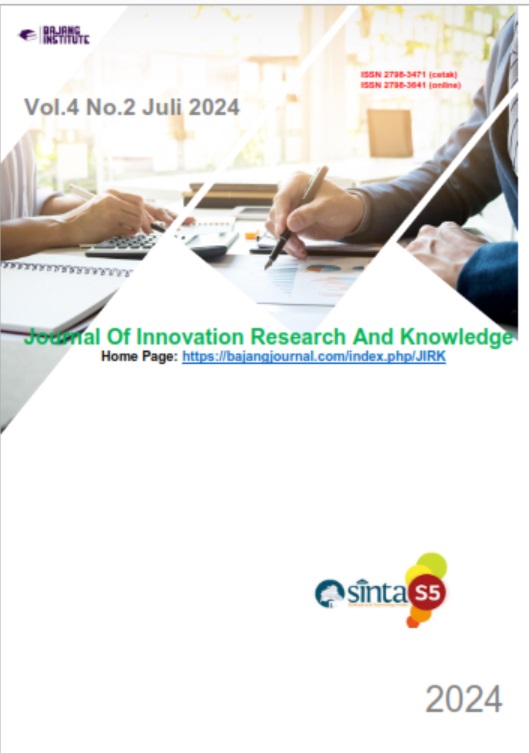ECOTOURISM DEVELOPMENT STRATEGY AT TAMAN WISATA ALAM GUNUNG TUNAK, CENTRAL LOMBOK
DOI:
https://doi.org/10.53625/jirk.v4i2.8117Keywords:
Ecotourism Development, Gunung TunakAbstract
Due to its high biodiversity, TWA Gunung Tunak is susceptible to disturbance. In order to develop as an ecotourism destination, management must implement proper sustainable measures due to the limited supply of natural resources. Descriptive qualitative methods are used in data analysis procedures, such as participant observation, in-depth interviews, and document analysis. This approach places a strong emphasis on in-depth knowledge in order to support the creation of guidelines and procedures for the growth of ecotourism destinations. Human resources, destination management, environmental sustainability, sanitation, security, and comfort are just a few of the barriers that may stand in the way. The following strategies are implemented in order to develop potential and find solutions to these obstacles: weakness-opportunity (W-O) strategies with tourism destination promotion strategies and security and comfort improvement strategies; weakness-threat (W-T) strategies with human resource development strategies and institutional development and destination management strategies; strength-opportunity (S-O) strategies with tourism destination development strategies and tourist attraction development strategies; strength-threat (S-T) strategies with environmental quality improvement strategies and ecotourism tourism development strategies. In summary, there is a great deal of potential for the development of TWA Gunung Tunak as an ecotourism destination. This potential encompasses socio-cultural elements like local knowledge and the warmth of the locals, as well as natural elements like the scenic beauty of the mountains, beaches, and woods.
References
Jurnal Terapan Pemerintahan Minangkabau Vol. 2, No. 2, Edisi Juli – Desember 2022, pp.143-162
Ersya Mayana, E. M.& MayanaE(2019). Potensi Obyek Wisata Taman Wisata Alam Gunung Tunak. Jurnal Sosial Ekonomi Dan Humaniora, 5(2), 134- 139
Andriani, Dini, and I. Gde Pitana. "Ekowisata: Teori, Aplikasi, dan Implikasi." Jurnal Kepariwisataan Indonesia 6.2 (2011): 181-193.
Haryanto, Joko Tri. "Model pengembangan ekowisata dalam mendukung kemandirian ekonomi daerah studi kasus provinsi DIY." Jurnal Kawistara 4.3 (2014).
Nafi, Mochammad, Bambang Supriyadi, and Nanny Roedjinandari. "Pengembangan Ekowisata Daerah." Buku Bunga Rampai 1.33 (2017): 38-45.
Sutisno, Aliet Noorhayati, and Arief Hidayat Afendi. "Penerapan Konsep Edu-Ekowisata Sebagai Media Pendidikan Karakter Berbasis
Kanom, S.Pd.,M.Par. 2020, Jurnal Ilmiah Pariwisata
Randhi Nanang Darmawan Politeknik Negeri BanyuwangiJurnal Ilmiah Pariwisata, Volume 25 No. 2 Juli 2020 Pengembangan Taman Wisata Alam Gunung Tunak Sebagai Destinasi Pariwisata Ekowisata Kanom*
Arjana, I. Gusti Bagus. Geografi pariwisata dan ekonomi kreatif. PT. RajaGrafindo Persada-Rajawali Pers, 2017.
Dewi, Made Heny Urmila. "Pengembangan desa wisata berbasis partisipasi masyarakat lokal di Desa Wisata Jatiluwih Tabanan, Bali." Jurnal Kawistara 3.2 (2013).
Prafitri, Gita Ratri, and Maya Damayanti. "Kapasitas Kelembagaan Dalam Pengembangan Desa Wisata (Studi Kasus: Desa Wisata Ketenger, Banyumas)." Jurnal Pengembangan Kota 4.1 (2016): 76-86. Lingkungan." Ecolab 12.1 (2018): 1-11
Solang, Jeanlly Adri. "Alur Kerangka Teori Pemanfaatan Kawasan Pesisir untuk Ekowisata." Jurnal Ekowisata 8.VIII November (2009): 31-36.













